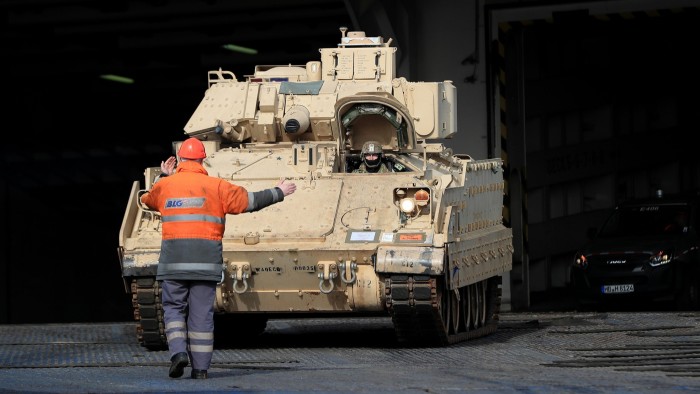Unlock the Editor’s Digest for free
Roula Khalaf, Editor of the FT, selects her favourite stories in this weekly newsletter.
Bellicose rhetoric from the US on the need for Europe to play a bigger role in defence is unleashing a fresh rally in the continent’s defence stocks. Demand for tanks, soldiers and ammunition is a given. Less clear is whether industry is in a position to capitalise on it.
US defence companies have done a tidy job of parlaying government spending into robust investor returns, via hefty research and development spending, economies of scale and handy deployment of tech. But Europe is a fragmented landscape, with different countries procuring to different specifications. Lack of co-operation costs the bloc between €25bn and €100bn annually, the European Commission has calculated.
What scale European companies do have is at least partly due to the US market, which accounts for two-fifths of sales at BAE Systems, or more than Europe and the UK combined. At Airbus it contributes more than a fifth, and at Leonardo more than a quarter, on 2023 numbers.

Creating a US-style unified market of near-30 countries is not going to happen. But unified standards and specifications are perfectly possible; at least a clutch of (generally smaller) countries are in harmony on, say, rifle specs. That could be extended, thus enabling more efficient capacity utilisation and expanding economies of scale.
Likewise, facilitating joint investment across borders would strengthen supply chains and ultimately bring down unit costs. Defence manufacturers rely on a swath of parts and components and would benefit hugely from agglomeration on a European scale.
Consolidation at the top end is the stuff of fantasy. Collaboration is not. Pooled resources, be it manufacturing platforms, R&D or joint procurement, all help with both capacity and costs.
There is precedent too. Take the MBDA missile manufacturing joint venture run by BAE Systems of the UK, France’s Airbus and Leonardo of Italy. The trio are also involved in the consortium producing the Eurofighter flagship combat aircraft. Leonardo and Germany’s Rheinmetall are joining forces to develop and market the new Italian main battle tank through a 50-50 joint venture.
Challenges to all this are legion and gaps remain. When it comes to software, Europe is light years behind the US; after all, that country’s tech industry was fathered by the Pentagon. German drone and defence AI start-up Helsing, valued at €5bn, pales beside America’s Palantir — market cap $270bn — and its start-up spawn Anduril, reportedly shooting for a $28bn valuation.
Still, industry momentum has been rising since Russia invaded Ukraine. Far from just collecting big order books, European manufacturers have introduced efficiencies in factories and supply chains. Equipment delivery times have already improved, according to industry sources. They are also corralling new processes, such as 3D printing.
More acceleration is possible. After all, if Ukraine was able to build a drone production from zero to 4mn-plus — while fighting a war — it should not be beyond Europe’s stalwarts to start plugging gaps and readying themselves for a rush of orders.
Read the full article here




